
I haven't fully dug out all available info on this company yet but I gather Grundy were some sort of furniture manufacturer.....anyhoo, roll back the clock a bit and we find a company called Sinclair Radionics (yes, that Sinclair, this was before the days of the ZX80) developing the original Newbrain because of a deal they had with the National Enterprise Board; the fact that this machine was being developed at all was the main reason Chris Curry left Sinclair to start Acorn with Herman Hauser. Quite why the NEB moved Newbrain development to Newbury Labs I haven't found out yet.
Roll forward a bit and we find that Newbury Labs seemed to be the BBC's (the corporation, not the machine) sole supplier for their forthcoming BBC Micro and their TV series on computing ("The Computer Programme"). In common with most other machines of the day, the prototype Newbrain was a Z80 based machine with 32K RAM and pretty smart graphics capabilities. Substantially more maximum memory than other machines at the time was also planned - up to 2mb if memory serves - as long as you bought enough expansion interfaces.
However, Newbury were having problems with manufacturing ULAs (uncommitted logic array - basically lots of TTL chips packed together in a single chip), also Chris Curry and Clive Sinclair found out about the BBC's plans and were slightly upset. This caused the BBC to throw the contract out to other manufacturers, hence the bidding war between Sinclair/Acorn/Newbury and a couple of others. As we all know, Acorn won the day with their 'Proton' machine (the followup to the Atom) after they got a mostly working example off to the BBC in under a week.
Here's some info from Steve O'Hara-Smith after I'd found him on a newsgroup and asked him if he was one of the designers:
" I wouldn't go that far - I was technical grunt work on that
job - but yes I was among the responsible parties. I wasn't around
when the whole think moved from Newbury to Grundy (it was during term)
but when I got my hands on one sometime later it was pretty clear
that the ULAs never arrived and Grundy put the prototype (or something
very close to it) into production - probably at a stonking great loss."
job - but yes I was among the responsible parties. I wasn't around
when the whole think moved from Newbury to Grundy (it was during term)
but when I got my hands on one sometime later it was pretty clear
that the ULAs never arrived and Grundy put the prototype (or something
very close to it) into production - probably at a stonking great loss."
"Have you noticed the way the small keyboard is remarkably usable
because the centers are the same spacing as a normal keyboard - it was
copied preceisely from a Newbury Labs terminal. I had to lay one atop
the other before I believed it. The case was made to fit the keyboard
layout, and half a ton of plastic was made into cases long before there
was anything resembling working hardware."
because the centers are the same spacing as a normal keyboard - it was
copied preceisely from a Newbury Labs terminal. I had to lay one atop
the other before I believed it. The case was made to fit the keyboard
layout, and half a ton of plastic was made into cases long before there
was anything resembling working hardware."
"Chris [hardware designer, Ed] gained us a couple of square inches of board space by
making the metal bit stick out of the back a bit :) The ULAs would
have made it neat again."
making the metal bit stick out of the back a bit :) The ULAs would
have made it neat again."
"[ULA problems] The problem was the specs said there were so many cells on the
chip and you could clock them up to such and such a speed. They didn't
allow for the detail that if you clocked too many cells that fast it would
melt. Neither did the designers trying to make boards full of TTL vanish
into ULAs. These days these details tend to be documented - some paid the
price of finding the pitfalls."
chip and you could clock them up to such and such a speed. They didn't
allow for the detail that if you clocked too many cells that fast it would
melt. Neither did the designers trying to make boards full of TTL vanish
into ULAs. These days these details tend to be documented - some paid the
price of finding the pitfalls."
It's known that Newbury Labs sold the whole thing to Grundy when they failed to win the contract. The lack of ULAs meant the whole machine was built using TTL logic when most other machines were already using ULAs, and that also meant the Newbrain ran really hot because everything fitted on 3 separate boards that were connected together using fragile single-core ribbon cables, and there isn't any spare room inside that little case. Also, everything had to be soldered, not socketed, because of airflow and heat dissipation.
Another mail from Gerald McMullon, who was at Grundy Business Systems right up to the bitter end:
"The NewBrain project was one of many that Clive Sinclair started. Mike
Wakefield was the designer and Basil Smith the software engineer. When it
was shown that it could not be built and sold for the sub-£100 Clive
Sinclair wanted another design. The project got sold to Newbury Laboratories
who made printers and VDU terminals in a cream and brown colour. The
NewBrain was to be silver and orange. When the prototype case was run off it
was a few pounds to make brown and or cream (Newbury colours) but a
re-tooling to run with different ABS plastic colours. So the prototypes were
cream and brown. I think production went that way because no one told the
manufacturer to switch the colour."
Wakefield was the designer and Basil Smith the software engineer. When it
was shown that it could not be built and sold for the sub-£100 Clive
Sinclair wanted another design. The project got sold to Newbury Laboratories
who made printers and VDU terminals in a cream and brown colour. The
NewBrain was to be silver and orange. When the prototype case was run off it
was a few pounds to make brown and or cream (Newbury colours) but a
re-tooling to run with different ABS plastic colours. So the prototypes were
cream and brown. I think production went that way because no one told the
manufacturer to switch the colour."
Gerald also passed on a shedload of information so I've created a separate page for that.
There were 3 models of machine, the "A" which was just the machine itself, the "AD" which featured a 14 character LED that echoed screen contents and the "M" which was intended to be a "Mobile" variant for Pharmaceutical types - there's a battery pack mentioned in the schematics.
The machine also featured 2 1200 baud cassette interfaces, an expansion port, RS232 port, Centronics printer port, RF and Composite video connectors so you could plug into either a TV or a monitor. The enhanced BASIC was pretty powerful for the time, although the lack of descriptive error messages meant you had to keep diving into the error codes at the back of the manual.
All in a very compact machine that was really only slightly bigger than the Spectrum turned out to be.
This machine was donated by Geoff McHugh and came winging its way over from Northern Ireland - cheers Geoff! He also passed on some expansion interfaces including at least 2 disk interfaces, but I haven't got enough power supplies to run anything other than the machine. According to Steve all the parts were off-the-shelf at the big electronic retailers; indeed the motherboard connectors are all Bergs, so it might still be possible to get hold of spare plugs etc to fix the other 2 PSUs I've got.
Recently arrived is a UK spec machine from Matt Simpson; I've given it the usual TLC but it's still not happy so more work required there. Also, the manuals have managed to re-form into trees, given their solidity. Time for a warm dip for those to see if they can be reconstituted! Thanks Matt :)
Pictures
 |  |  |  |
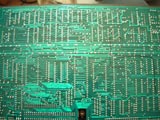 | 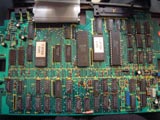 | 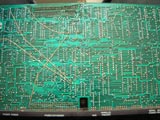 | 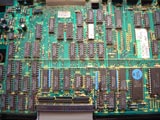 |
 | 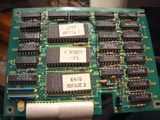 |  | 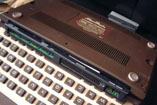 |
 |  |  | 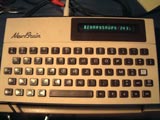 |
 |  |  | 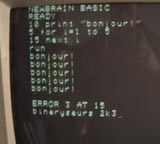 |
 |  | 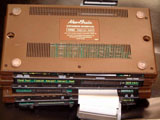 |  |
 |  |  |  |
2017 Update
A fellow collector messaged me recently to ask if I had a working 'brain PSU since he was working on one he'd
received a while back, his seemed totally dead. This was an ideal chance to test my own pair of 'brains and I was susprised to
see my UK one worked! Ish. For 10 minutes. There followed a few nights of logic analysing, scoping and tracing of circuits to
try and find why the display was showing as you can see in the pictures. Eventually persistence (and a bit of luck) paid off and
the fault was traced to a 74LS166 shift register. Solder in a new one and we're back in business again!
Things to beware of when resuscitating a 'brain are the PSU, startup circuit and the fact that the store board contains
16x 4116 RAM chips which aren't known for their longevity.
PSU
The PSU is a +7.5/+13.5/-14VDC unit with primary regulation in the PSU itself, a pair of TIP31A transistors. I guess it's
rated this high to allow you to run the expansion unit and disk interface which all came with power jumper cables, not their own PSU.
The PSU also contains en example of everyone's favourite RIFA mains filter cap (usually the RIFA PME271M aka 'container of the magic smoke') but in this case it's a Delta Network of one .1uF and 2 4700nF filters. Still available replacements are RIFA/KEMET PZB4003/23B. In the 'brain itself the reason for the big metal heatsink on the back is the pair of 2N5193 power transistors acting as secondary regulation. In a working machine all 3 pins roughly match +12 (board position 8) and +5 (board position 22)
The PSU also contains en example of everyone's favourite RIFA mains filter cap (usually the RIFA PME271M aka 'container of the magic smoke') but in this case it's a Delta Network of one .1uF and 2 4700nF filters. Still available replacements are RIFA/KEMET PZB4003/23B. In the 'brain itself the reason for the big metal heatsink on the back is the pair of 2N5193 power transistors acting as secondary regulation. In a working machine all 3 pins roughly match +12 (board position 8) and +5 (board position 22)
Also check for the correct voltages on the RAM chips:
pin 1: -5V
pin 8: +12V
pin 9: +5V
pin 16: GND
pin 1: -5V
pin 8: +12V
pin 9: +5V
pin 16: GND
Startup Circuit
Capacitors 125 and 127 (both 10uF 25V) fail/dry meaning PWRUP and RESET are never asserted so the machine won't boot.
Check pins 4 and 6 on IC452 for +5V after 5-10 seconds.
IC452 itself fails so again no PWRUP and RESET. Outputs of caps 125 and/or 127 climb slowly and never reach the trigger point, check pins 3 and 5 of IC452.
CPU pins to check:
pin 11: +5V
pin 6: clock, with a DMM will show around 2V
pin 20: RESET
IC452 itself fails so again no PWRUP and RESET. Outputs of caps 125 and/or 127 climb slowly and never reach the trigger point, check pins 3 and 5 of IC452.
CPU pins to check:
pin 11: +5V
pin 6: clock, with a DMM will show around 2V
pin 20: RESET
IC436 (74LS166N shift register) fails - no screen output or garbled text.
Other general failures and weird happenings may be down to dried out electrolytics, nearly all 47uF 6.3V and 10uF 25V. On some boards capacitor 104 is labelled wrongly with the + on the board being in the wrong place. Take note of cap orientation!
Other general failures and weird happenings may be down to dried out electrolytics, nearly all 47uF 6.3V and 10uF 25V. On some boards capacitor 104 is labelled wrongly with the + on the board being in the wrong place. Take note of cap orientation!
RAM
The 'brain does a RAM check when its booted and PRINT FREE will show what's left. It's 32K memory is
in two banks of 4116-25 like the CBM PET and similarly if BANK0 has a bad chip in it the machine won't boot. You can test this by jumpering Pin
1 to Pin 6 on the 50-way expansion connector which swaps the RAM banks over. If you get a BASIC prompt but less memory than expected you can do this:
POKE 20000,0:?PEEK(20000)
If it returns 0 then go to the next test, but if it returns 1, 2, 4, 8, 16, 32, 64 or 128 then that corresponds to a bad chip with 1 signifying IC416 and 128 signifying IC409.
If it returns 0 do this:
POKE 20000,255:?PEEK(20000)
which should return 255. A bad chip is signified by a return value of 255-(1,2,4,8,16,32,64,128).
Also on the store board are a pair of 10uF 25V caps which like all the others can and will fail. It's imperative to fully clean around the mounting
holes for these caps otherwise strange things happen.
This was also an ideal chance to test the many expansion interfaces I have.
Pictures
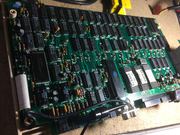 | 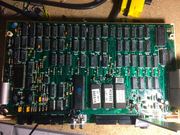 | 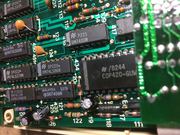 | 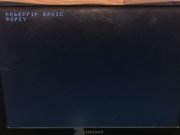 |
 |  |  |  |
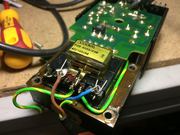 | 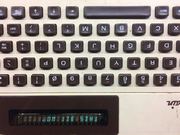 |  | 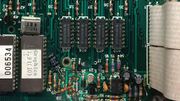 |
 | 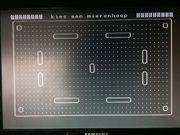 | 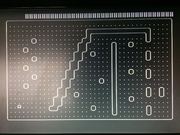 | 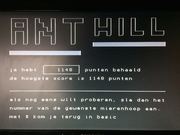 |
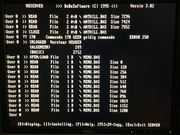 |  | 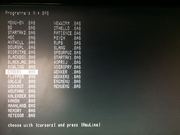 |  |
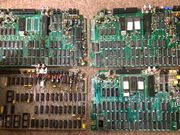 | 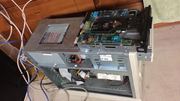 |  | 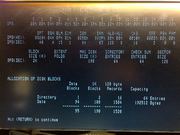 |
 |  |  |  |
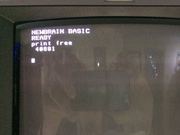 | 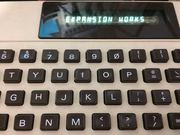 | 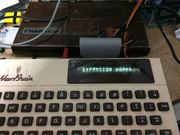 |  |
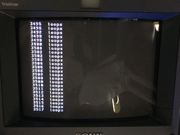 | 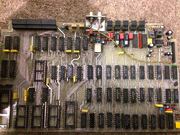 | 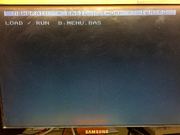 |  |
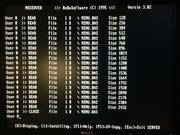 |  | 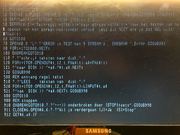 | 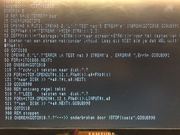 |
 |  | 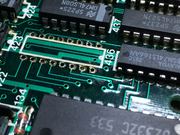 |  |
 |  |  |  |
2018 Update
Success in getting a Gotek floppy emulator to boot a Newbrain into CP/M is documented here.
Related Links
string(14) "/Museum/Grundy"
string(24) "/Museum/Grundy/index.php"
A news item about Sinclair's sale of the NewBrain to Grundy Business Systems